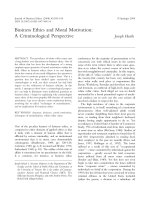Global business ethics lesson 08
Bạn đang xem bản rút gọn của tài liệu. Xem và tải ngay bản đầy đủ của tài liệu tại đây (1.42 MB, 12 trang )
77
Environmental Issues
UNIT 1
UNIT IV
78
Global Business Ethics
79
Environmental Issues
LESSON
8
ENVIRONMENTAL ISSUES
CONTENTS
8.0
Aims and Objectives
8.1
Introduction
8.2
Scope of Environmental Ethics
8.3
Protecting the Natural Environment
8.3.1
Land
8.3.2
Water
8.3.3
Forests
8.3.4
Dams
8.3.5
Atmosphere
8.3.6
Habitat
8.4
Health
8.5
Prevention of Pollution
8.6
Protecting the Natural Environment
8.7
Let us Sum up
8.8
Lesson End Activity
8.9
Keywords
8.10
Questions for Discussion
8.11
Suggested Readings
8.0 AIMS AND OBJECTIVES
After studying this lesson, you should be able to understand:
z
The scope of environmental ethics
z
Various environmental issues
8.1 INTRODUCTION
Over the course of the past twenty years there has been an enormous increase in
general public awareness of the environmental issues. The highest profile world- level
event was the United Nations Conference on Environment and Development (the
Earth Summit) which attracted 178 nations to Rio de Janeiro in June 1992, including
over 100 heads of state. Simultaneously almost 500 groups (Non- Governmental
Organizations, or NGOs) were involved in a global forum some miles away from the
official meetings. More than any single event before or since, this summit and forum
raised matters such as climate change, biodiversity and the sustainability of
development to a new level in the consciousness of society around the world.
80
Global Business Ethics
8.2 SCOPE OF ENVIRONMENTAL ETHICS
The environmental problems in India arise from a number of causes. The growing
human and animal populations are making increasing demands on natural resources
resulting in the exploitation of resources in an unsustainable manner. The general
indifference of the industries sector on aspects of environmental safety and protection
is leading to air, water, and soil pollution. Economic growth has necessitated a
corresponding expansion in energy availability for industrial, agricultural and
domestic purposes. The energy mix in the country is such that India has been listed
the fifth biggest contributor of greenhouse gases by the World Resources Institute.
The level of environmental literacy is low, and thus there is a gross undervaluation of
the economic and ecological aspects of biological diversity. Also, extensive damage is
being done to basic life-support systems caused by development activities. The
policies of the central and state governments have not incorporated environmental
accounting principles with the result that many development projects have been
conceived for short-term gains without considering their long-term ecological and
social impacts. The inability to convert the oft-repeated rhetoric of growth with equity
into reality has resulted in the persistence of widespread poverty, under-nutrition and
under-five infant mortality. Also, the biomass needs of the tribal and rural people are
neglected. Thus, fifty years after independence, while the country has achieved great
gains in industry and agriculture, it has failed on the family planning, poverty
alleviation and environmental protection fronts. The new environmental ethics will
have to find solutions to these problems.
z
Atmosphere
z
Habitat
z
Health
8.3 PROTECTING THE NATURAL ENVIRONMENT
8.3.1 Land
With just a fortieth of the world's land, India supports over half of its buffaloes and
over a seventh of its cattle and goats. As more and more grazing lands are brought
under the plough, often, as a result of government programmes, the remaining move
towards overstocking and economic disaster. As grazing lands degenerate, people
keep more goats, which survive better in hostile environment. In Rajasthan, the
number of goats was half that of cattle. By 1983 there were 14 goats to every 10 heads
of cattle. As fodder becomes scarce, people and the animals turn to forests. Violent
clashes between grazers and foresters follow, as corrupt foresters exploit permits for
grazing. The worst affected are millions of nomads as their cattle starve and they
travel ever-increasing distances. Finally, they give up their traditional life style to
become landless labourers. Scientists recognize that nomads, invariably worked on
marginal lands which soon collapsed under permanent agriculture. Ironically when the
country faces an acute fodder crisis, social forestry programmes intended, to meet this
and the fuel wood crisis, plant mainly non-browsable species like eucalyptus. Ravines
have already swallowed up four million hectares. In the Chambal Valley, more than
ten per cent of the villagers have been completely depopulated. While mineral
production in rupee terms has increased, nearly fifty-fold in the last thirty years,
mining operations have depopulated hundreds of villages and destroyed several
million hectares of good crop and forestland. The worst affected are the tribal. More
than half of the national mining output comes from 40 contiguous districts of central
and eastern India, the tribal heartland of the country.
8.3.2 Water
India is one of the wettest countries in the world. Its average annual rainfall is 1170
mm with Cherapunji in the East getting drenched under 11400 mm plus and the sands
of Jaisalmer at the western end getting 210 mm. Considering that the mid- western
US, the breadbasket of the world, gets an average of 200 mm a year, India should
consider itself singularly fortunate. However the country does not use its blessings
properly, hence, two decades from now India is expected to face the threat of shortage
for it, cannot hold on to all the water it receives. Deforestation is the main cause of
this gloomy scenario. Soil conservation has been so far neglected in such a manner
that every year a large portion of the monsoon water disappears into the sea.
Today, India uses only and tenth of the rainfall it receives and even forty years from
now, it will be using only a quarter. But it must learn to store the water adequately and
use it without polluting it. Otherwise there will be serious water shortages. India's
groundwater resources are almost ten times its annual rainfall but with over 70,000
tube wells added every year; the water table is declining in many areas leaving the dug
wells of the poor high and dry. Ancient India stored rainwater in tanks and ponds but
the British and the independent Indian administration have neglected them
completely. So where tanks irrigated half the cropped area a century ago, they now
irrigate less than 10 per cent.
All but two of the high altitude lakes are steadily dying because of pollution. The slow
death of Kashmir's Dal Lake is ruining the life of 50,000 fisher folk.
The ecological value of wetlands has yet to be understood. Calcutta's Salt Lake City
today, stands on a former sprawling we find and the result is with the city's natural
drainage system blocked, every shower turns into a flood and the city has lost major
sources of fish, its favourite food. The increasingly polluted rivers and lakes and large
dams are seriously affecting riverside fisheries. The migratory 'hilsa', much soughtafter delicacy, is being damned to death. Thus, as a consequence of pollution and
unplanned industrialization, millions of riverside fisher folk, their survival is very
uncertain, so they travel long distances and months in search of fish.
Both droughts and floods have ravaged India over the last decades/The increasing
pace of environmental destruction is in turn increasing the hazard-proneness of the
affected areas. A N Amphora, the retiring chairman of the Brahmaputra Board said in
early 1984 that the annual flood damage to Assam alone was more than 2,000 crores
of rupees. The high watermark at Dibrugarh on the river Brahmaputra has risen
gradually over the past forty years and since 1960, has always been above the danger
mark. The systematic destruction of the forest for the various plywood and timber
factories have caused soil erosion which have raised Brahmaputra's bed level, thus
causing destructive floods which have become an annual feature in the Brahmaputra
basin in recent years.
8.3.3 Forests
Of all the environmental problems facing the country, the problem of deforestation
has received the maximum public attention. The latest satellite data confirm that India
is losing 1.3 million hectares of forest every year, nearly eight times the annual rate as
given by the forest departments. Wood has become so expensive Tamil Nadu fisher
folk find it difficult to make catamarans, Karnataka villagers find it difficulty buy new
bullock carts and Andhra toy makers find it difficult to make new toys. Nine dams
that have been built along the river Indravati in Baster, India's last tribal frontier, are
turning the tribals into refugees in their own homeland besides damaging the fragile
economic system. Baster's forests are also threatened with mines and wood- based
industries. Social forestry schemes envisage the planting of eucalyptus, but the tree is
not very popular with the environmentalists. In Karnataka, protests have uprooted
eucalyptus in several places while some farmers have dug trenches between the
81
Environmental Issues
82
Global Business Ethics
eucalyptus and their fields to keep the eucalyptus roots away. The fast growing
eucalyptus plantations are depleting soil nutrients in Punjab, UP and Haryana. Social
forestry may even be exacerbating the energy crisis for land less labourers when
farmers in Punjab switched from cotton to eucalyptus the workers lost their main fuel,
the cotton stalks.
Thus, the destruction of the forests in India have had a devastating impact on the
Indian ecosystem. The unprecedented drought in Kerala in 1983 was largely caused
by the destruction of the forests on the slopes of the Western Ghats. The power
(electricity) rush has caused the destruction of the forests. It has led to a vicious circle.
In order to remedy the regular power cuts during summer, more dams are built which
further damage the catchment area, reduce water availability, and consequently the
power-generating capacity of the project. The time has come to reverse this trend.
8.3.4 Dams
Large dams are the most controversial environmental issues facing India today. Silent
Valley, which envisaged large-scale destruction of the only remaining tropical
rainforest in the country along with the various rare species of flora and fauna, has
already been given up after the environmental groups protested. The cost of forest loss
due to construction of dams is very high and large dams have disowned half of a
million hectares of forests. As much as nature is affected, dams also affect the lives of
numerous local people. The government officials argue that, 'someone has to suffer
for progress.' Usually these 'someone' are tribals, the poorest and the most powerless.
Rehabilitation measures for the displaced are highly pathetic. Some of the current
irrigation projects that would be damaging the ecosystem are:
The Narmada basin development programme costing more than Rs. 25,000 crore and
displacing over one million tribal people:
z
The Koelkaro project in Bihar
z
The Indravati project and Upper Indravati project covering the states of Orissa,
Andhra Pradesh, Madhya Pradesh and Maharashtra
z
The Vishnu project
z
The Tehri project
z
The Kopili project at Garampani, Meghalaya
z
The Ranaguadi project, Arunachal Pradesh
All these projects result in massive deforestation, soil erosion, pollution, wildlife
destruction, cultural ethnocide. Though these projects promise thousands of
megawatts of electricity and millions of hectares of irrigated land, in the long run the
environmental chaos is bound to reverse these temporary gains. Small earthen dams
for water harnessing are both ecologically sound and economically profitable. There is
no soil erosion, no deforestation, destruction and no one is displaced. The lesson:
water conservation yes; big dams, no. It's time our planners and government took note
of this.
8.3.5 Atmosphere
The government's decision to set up giant thermal power stations to meet the country's
power shortage is being implemented with relative efficiency. But the need to control
pollution and plan for a clean environment for human settlements coming around
these stations is yet to be seriously felt by the government. The government agencies'
lack of co-ordination and will to take effective steps has resulted in a massive
environmental destruction for miles around, and the threat of acid rain in especially
developing countries. Most of the thermal power stations do not have properly
functioning pollution equipment. The current vehicle boom in the Indian cities could
choke thousands to death. Delhi's half a million motor vehicles spew 400 tons of
pollutants daily. Air pollution could be a major cause of TB and major respiratory
ailments. Industrialization around the urban belts has led to passive increase in the
atmospheric sulphur dioxide content. The trend to set up super thermal power stations
could only increase pollution. As Prof. C V Sheshadri said, 'Power pollutes, super
thermal power pollutes super thermally.
8.3.6 Habitat
India's urban population is today the fourth largest in the world. In the 21st Century, it
would be the largest. As towns and cities grow they gobble up precious agricultural
land. Conservative official estimates put the slum population at over 30 million. In the
21st century about 75 per cent of Mumbai's population will be living in slums.
Conditions in the slums are more than choking. A survey reveals, in Mumbai nearly
40 per cent of the slum households have two to four persons packed in one room, 35
per cent of households have five to nine people cramped into one room. No house has
a private toilet. A quarter of the households does not even have access to community
toilets and use open spaces around the slum for defecation. Over a third have no
drainage facilities and another 40 per cent have uncovered drains. This lack of
amenities makes the slum environment extremely dirty and prone to sickness. The
recent outbreak of the cholera epidemic in Delhi is a classic example of the
degeneration of the habitat. The data available on India's major cities indicates that the
most common illnesses prevalent are the respiratory diseases, gastrointestinal
disorders, skin diseases, worms, infections and TB. Grossly inadequate supply of
clean water, overcrowding, congestion and the near total lack of sanitary facilities
have done their bit to help the disease get the upper hand in slums. It is high time the
government upgraded the living conditions in the slums.
The face of urban India is rapidly changing. Bangalore, Pune, and Dehradun for long
praised as idealistic - cool, green and quiet - are boomtowns - noisy, dusty, and hot.
Hill stations are dying everywhere. In place like Ooty in the South, Mahabaleshwar,
Panchgani in the West, Darjeeling, Gangtok, Shillong, Musoorie and Shimla in the
North, with tourists pouring in, forests have been destroyed and water crisis is
common. It is time that the rapid degeneration of the habitat is stopped.
Check Your Progress 1
What are the environmental issues related with dams projects?
………………………………………………………………………………….
………………………………………………………………………………….
8.4 HEALTH
India's chemical industry with 4,000 factories is the most dangerous one in the
country. India uses nearly 100,000 tons of pesticides annually. At least 70 per cent of
this tonnage is contributed by pesticides, banned and severely restricted in the western
world. A WHO study which analyzed food samples across India found that 50 per
cent were contaminated with pesticides and residues, with 30 per cent, exceeding
permissible limits. Over 2,500 died in the world's worst chemical industry disaster,
when methyl isocyanate (MIC) gas leaked from the Union Carbide factory in Bhopal.
Thousands of workers die everywhere because of occupational diseases, the gravest
one caused by various types of dust like asbestos dust, slate pencil dust, and the dust
at various mining sites. One million miners suffer from silicosis.
83
Environmental Issues
84
Global Business Ethics
Mosquito-born diseases are rapidly growing and grossly under-reported. Malaria
incidents may be as high as 20 million though official statistics claim only 2.16
million. Malaria, dengue, Japanese encephalitis and various other epidemics are a
result of the steady degeneration of the environment.
The above analysis indicates the severity of environmental destruction in India. It is
time for the government to muster the political will and courage to reverse the
environmental degeneration. If the Government does not act, the progressive
environmental degeneration will worsen the plight of the poor and the rich alike.
8.5 PREVENTION OF POLLUTION
As an environmental management strategy, pollution prevention shares many
attributes with cleaner production, a term used more commonly outside the United
States. Pollution prevention encompasses more specialized sub-disciplines including
green chemistry and green design (also known as environmentally conscious design).
The types of pollution can be classified as:
1. Anthropogenic (Human caused) Sources of pollution
Air Pollution
Water Pollution
Soil Pollution (Contamination)/Land Pollution
2. Economic source (originator) of Pollution
Agricultural Pollution
Industrial Pollution
Transport Pollution
a) Car pollution
b) Ship pollution
c) Airplane pollution
Commercial and domestic sector pollution
3. Natural sources of pollution
Volcanic eruptions
Dust storms
Smoke from forest and grass fires
4. Other types of pollution
Radioactive pollution (contamination)
Chemical pollution
Invasive species pollution
Light pollution
Noise pollution
Visual pollution
Pollution prevention (P2) describes activities that reduce the amount of pollution
generated by a process, whether it is consumer consumption, driving, or industrial
production. In contrast to most pollution control strategies, which seek to manage a
pollutant after it is formed and reduce its impact upon the environment, the pollution
prevention approach seeks to increase the efficiency of a process, thereby reducing the
amount of pollution generated at its source
All the people such as Blacks and whites, women and men, young and old, developing
and developed can rise above their mutual bitterness to identify a shared
powerlessness and to plan a shared future.
A world-order framework identifies the passage of our present system and provides
hope for the future. Such hope and belief provide a basis for determination, for the
staying power needed to successfully deal with the complexities of local issues. They
also provide a basis for initiative in seeking new responses and alternatives to local
problems as well as to global crises. It provides a perspective of analyzing each
problem in a macro frame that identifies all the forces intruding upon it, analysing it
and provide more effective problem solving.
In highly developed mainly western countries up to 90% of all forest has disappeared
to urbanization and agriculture, with many other areas having followed suit with
figures nearly as high at 80%+. In total 80% of the worlds forest has been cleared or
compromised by human development.
Most mountains in the Himalayas have been grossly denuded and women have to
walk several kilometres daily to collect fuel. The consequences of deforestation - soil
degradation, groundwater depletion and frequent occurrence of floods and droughts have been amply demonstrated.
The effects of this deforestation and climate change are felt worldwide though
particularly in very cold polar and low-lying areas susceptible to flooding. These
effects include extreme weather, flooding, and drought as well as warming leading to
environmental change.
Biologically, India is one of the richest nations with more than 15,000 species of
plants. Many of these are endangered due to deforestation.
As the human and industrial wastes pollute 70% of the water sources, the industries,
thermal power plants, automobiles etc. pollute the air in metropolitan cities.
The pollutants, mercury, lead, sulphates, nitrates, sulphur dioxide, carbon monoxide,
nitrogen dioxide, hydrogen sulphide and human excreta, and sewage cause medical
problems such as birth defects, damage to the nervous system, kidney diseases,
gastrointestinal problems, asthma, bronchitis, etc.
In 1995, for example, only 3.5% of global forest area corresponded to that under
plantations (Brown 2000). Nonetheless, the proportion of global, industrial
roundwood supplied from this resources in 1999 was estimated to be 35% and is
expected to exceed 40% in the near future.
In Latin America, plantations account for only 2.0% of the forested area, but supply
more than 27% of industrial round wood. In Chile, with its highly advanced plantation
industry, this percentage increases to 85% (Brown 2000) and in Costa Rica, a country
which has traditionally harvested its wood from natural forests, an estimated 62% of
round wood consumed now comes from plantations (Arce and Barrantes 2004).
Although plantations are often considered important for offsetting forest loss due to
deforestation, in most countries total plantation area is only a fraction of the area
deforested on average each year. The reduction of forest cover in many regions has
been accompanied by a steady increase in demand for forest products (FAO 1995).
Some of the possible steps that can be taken to control pollution are as follows:
z
Prefer organic manure to chemical fertilizers, paper to polythene, cotton, jute to
polyester.
z
Dispose polythene bags through proper channel.
85
Environmental Issues
86
Global Business Ethics
z
Plant more trees and vegetation
z
Keep smoke emission from homes, factories, vehicles to minimum.
z
Avoid use of firecrackers.
z
Dispose garbage in bins, do not bum it.
z
Reduce and alter indoor chemical use
z
Use more sophisticated furnace filters
z
Use spittoons or flowing drains for spitting.
z
Never dump garbage near communal taps, wells and other water bodies.
z
Do not tinker with public water pipes.
z
Immerse holy idols in authorized places.
z
Keep the volume of your T.V., music system low.
z
Honk the car horn sparingly.
z
Discourage use of loudspeakers.
z
Avoid the use of band, crackers in wedding processions.
8.6 PROTECTING THE NATURAL ENVIRONMENT
The agriculture is intensive - using more and more fertilizers and pesticides, which
pollute the water. The industry has diversified to produce many hazardous chemicals.
To meet the power requirements, hydroelectric, thermal and nuclear plants are being
increasingly set up. These generate several pollutants and wastes and efforts have to
be made to control these.
The problems of India, indeed of developing countries, are massive. The country has a
fast growing population, 40 per cent of which depends on the nature's gift of land,
water and forests for food, fuel, shelter and materials to provide them employment.
People put a tremendous pressure on the natural resources, compounded by the cattle
population of more than 40 crores.
The prosperous segment of the population, to meet its demands, turns to industrial
units, which cause heavy pollution and degradation of natural resources. The
combined effect is staggering, posing a big threat to the very process of development.
This vicious circle has to be broken if development is to be made sustainable.
In the last forty years, the government has taken a number of steps to protect the
environment. These include:
z
Enactment of legislations such as the Wildlife Protection Act, 1972; the Forest
Conservation Act, 1980; the Water Prevention and Control of Pollution Act, 1981;
The Air (Prevention and Control of Pollution) Act, 1981; and the Environment
(Protection) Act, 1986.
z
Setting up of a Central Pollution Control Board and 23 State Boards.
z
Fixing of industry-wise Standards for discharge of pollutants.
z
Extension of several financial incentives to industrial units installing pollutioncontrol equipment.
z
Declaring 4 per cent of the country's area as national parks and sanctuaries.
z
Taking up massive a forestation schemes through National Wastelands
Development Board.
z
The Gaga Action Plan to clean the river.
z
Making an environmental impact assessment and clearance by the Pollution
Control Boards mandatory for all industrial units.
z
Promoting research and development in universities and national laboratories.
Check your Progress 2
Fill in the blanks:
1. __________ were involved in a global forum some miles away from the
official meetings.
2. The __________ value of wetlands has yet to be understood.
3. The government's decision to set up giant __________ to meet the country's
power shortage is being implemented with relative efficiency.
8.7 LET US SUM UP
This Planet is not a legacy that we shall leave for our children but it is their Birth
Right to inherit it from us at least the way we got it from our grand parents. The
question is whether the present adult society is stealing their birth right. Are we
leaving this Planet with all its wealth, flora, fauna and ecosystem? Are we at least
letting them breathe fresh air and enjoy pure free water.
8.8 LESSON END ACTIVITY
Environment protection is a major issue in modern times. Do you agree with this?
Give reasons for your answer.
8.9 KEYWORDS
Environmental issues: Issues related to environmental problems.
Deforestation: Removal of the forest cover.
Soil conservation: Protecting the productivity of soil.
8.10 QUESTIONS FOR DISCUSSION
1. Discuss the available natural resources.
2. Enumerate the nature of environmental destruction in India.
3. What steps have been initiated at policy level to protect the environment in India?
4. What is air pollution, what are its problems?
5. Earth is warming due to human activity in the recent days. What are its views?
Check Your Progress: Model Answers
CYP 1
Large dams are the most controversial environmental issues facing India
today. Silent Valley, which envisaged large-scale destruction of the only
remaining tropical rainforest in the country along with the various rare species
of flora and fauna, has already been given up after the environmental groups
protested. The cost of forest loss due to construction of dams is very high and
large dams have disowned half of a million hectares of forests. As much as
nature is affected, dams also affect the lives of numerous local people.
Contd…
87
Environmental Issues
88
Global Business Ethics
CYP 2
1. Non-governmental Organizations
2. Ecological
3. Thermal power stations
8.11 SUGGESTED READINGS
Manuel G. Velasquez, Business Ethics.
Laura P. Hart Man, Business Ethics.
John R. Boat Right, Ethics in Conduct of Business.
William A. Wines, Ethics Law and Business.









